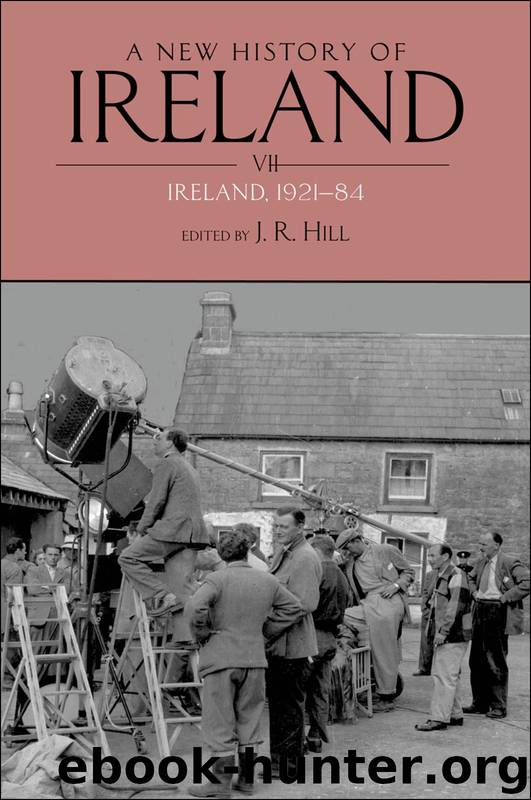New History of Ireland VII by Hill J. R.;

Author:Hill, J. R.; [Hill, J. R.;]
Language: eng
Format: epub
Publisher: Oxford University Press
Published: 2003-10-10T07:00:00+00:00
Literature in Irish, by Maire Ni Annrachain
THE revival of the Irish language, conventionally believed to have been placed on a firm footing with the founding of the Gaelic League in 1893, brought with it the challenge of breathing new life into a literature that had allegedly suffered the best part of 300 years of decline. The decline was generally held to have reduced it from the intense voice of a confident establishment to a frail whisper from a spent peasant culture.
Whether or not this recently challenged pessimistic analysis103 is accepted, it is certainly the case that early revivalists conducted a robust debate around the literary requirements and possibilities of the new Ireland. How to reconcile the demands of modernity and tradition? How to be faithfully indigenous while authentically modern? Would there be a single tradition or would there be two: the one modern, innovative, artistically self-conscious, urban, learner-driven, written; the other traditional, rural, conservative, produced for and by native speakers, and predominantly oral? Not all writers have found the same balance, but there has been general agreement, in practice if not always in theory, that finding some version of the balance had to be part of the communal project.
The initial preoccupation centered on questions of language, content, and form,104 particularly in relation to prose literature. There was a conservative view on these matters, which was propounded most vocally by Risteard de Hindeberg (Richard Henebry) in the Leader at the end of the first decade of the century. Holders of this view favoured remaining close to the last viable written standard, namely Gaeilge Cheitinn, the Irish of Keating, which was internally consistent, if untouched by oral developments in the language over the intervening 250 years. They also advocated indigenous forms, most notably the folk-tale, and desired to eschew imported forms such as the novel and the short story. For content, ‘modern’ themes, including love, were to be shunned as incompatible with the genius of the Irish language. De Hindeberg did not often spare the feelings of his opponents. Of Pearse’s story ‘Iosagan’ he said: ‘This is the frivolous petulancy of latter-day English genre scribblers, and their utterance is as the mincing of the under-assistant floor-walker of a millinery shop.’105
The modernising approach preferred cainnt na ndaoine, the spoken language, with all its dialectal diversity, inconsistency, and lack of experience in dealing with higher registers. In terms of form and content there was a firm rejection of the conservatives’ suspicion of the modern. Largely learners of Irish, and reared on literature in English, the modernisers willingly embraced the modern world, without losing sight of the native tradition. According to Patrick Pearse, they advocated that Irish literature should get ‘into contact on the one hand with its own past and on the other with the mind of contemporary Europe’.106
Pearse was the prime mover and most innovative literary theorist for Irish during the early days of the revival, though Padraic Ó Conaire, its most important fiction writer, was also an influential, modernising force in his theoretical writings.
Download
This site does not store any files on its server. We only index and link to content provided by other sites. Please contact the content providers to delete copyright contents if any and email us, we'll remove relevant links or contents immediately.
Waking Up in Heaven: A True Story of Brokenness, Heaven, and Life Again by McVea Crystal & Tresniowski Alex(37633)
Still Foolin’ ’Em by Billy Crystal(36226)
Cecilia; Or, Memoirs of an Heiress — Volume 1 by Fanny Burney(32395)
Cecilia; Or, Memoirs of an Heiress — Volume 3 by Fanny Burney(31772)
Cecilia; Or, Memoirs of an Heiress — Volume 2 by Fanny Burney(31740)
Fanny Burney by Claire Harman(26503)
Empire of the Sikhs by Patwant Singh(22921)
We're Going to Need More Wine by Gabrielle Union(18923)
Hans Sturm: A Soldier's Odyssey on the Eastern Front by Gordon Williamson(18447)
Plagued by Fire by Paul Hendrickson(17309)
Out of India by Michael Foss(16769)
All the Missing Girls by Megan Miranda(15440)
Cat's cradle by Kurt Vonnegut(15125)
Pimp by Iceberg Slim(14250)
Molly's Game by Molly Bloom(14039)
Bombshells: Glamour Girls of a Lifetime by Sullivan Steve(13940)
Leonardo da Vinci by Walter Isaacson(13124)
For the Love of Europe by Rick Steves(12433)
4 3 2 1: A Novel by Paul Auster(12244)
